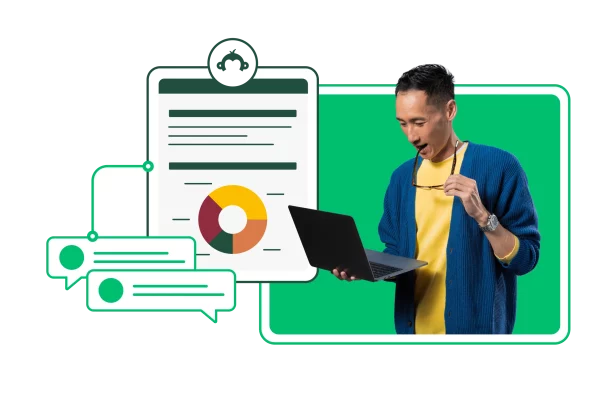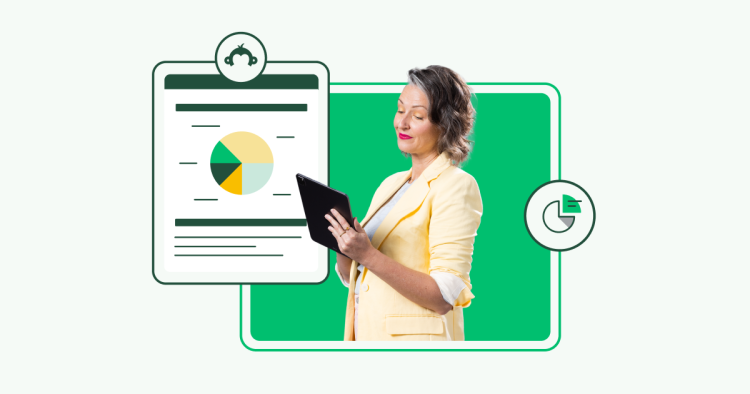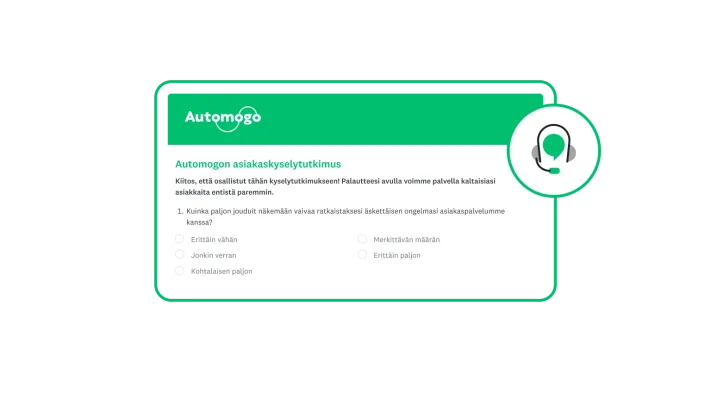Asiakas‑ ja markkinatutkimuksen kohderyhmät ja kyselytutkimukset

Asiakaspalaute on tärkeimpiä työkaluja, kun haluat saavuttaa kilpailuetua tai parantaa asiakasuskollisuutta.
Se auttaa ymmärtämään, mitä teet oikein ja mitä väärin, ja tarjoaa parannusten tekemiseen tarvittavia tietoja. Asiakaspalautteen keräämiseen on kuitenkin monia tapoja. Ensin onkin päätettävä, käytetäänkö siihen kohderyhmää vai kyselytutkimusta.
Olemme tehneet avuksesi tämän oppaan, jossa käydään läpi kohderyhmien ja kyselytutkimusten etuja ja haittoja. Lisäksi kerromme, milloin mitäkin tapaa kannattaa käyttää asiakkaiden näkemysten kartoittamiseen.
Mikä on kohderyhmä?
Kun tutkija järjestää kohderyhmän, hän valitsee huolellisesti muutamia henkilöitä, jotka vastaavat tiettyjä kohdemarkkinoita tai käyttäjäpersoonia. Kohderyhmässä tutkija kysyy kysymyksiä ja ylläpitää keskustelua ryhmän osallistujien kanssa. Yleensä kohderyhmät ovat interaktiivisia, ja niitä järjestetään neutraaleissa paikoissa, joissa ihmiset kokevat voivansa kertoa mielipiteensä rehellisesti.
Määritelmän mukaan kohderyhmän tarkoitus on tarjota selittäviä laadullisia näkemyksiä eikä tarkkaa määrällistä tutkimusdataa. Syynä on se, ettei analysoitavana ole suuri tietojoukko. Sen sijaan kuuntelet mielipiteitä, näkökulmia, henkilökohtaisia tarinoita ja anekdootteja. Näin voit saada paremman käsityksen tarjoamastasi asiakaskokemuksesta tai kohdemarkkinoistasi. Et kuitenkaan saa koko kohdepopulaatiota koskevia varmoja todisteita.
Kohderyhmistä saatavasta datasta voidaan kuitenkin tehdä arvokkaita havaintoja siitä, mitä asiakkaat ajattelevat ja miksi he ajattelevat tietyllä tavalla. Tämä tutkimusmenetelmä voi auttaa kehittämään markkinoillesi sopivan tuotteen, luomaan kiinnostavia mainoskampanjoita ja vastaamaan markkinoiden muutoksiin.
Mikä kyselytutkimus on?
Kyselytutkimus on tutkimusmenetelmä, jolla kerätään palautetta tietyltä ihmisjoukolta. Yleensä kyselytutkimukset luokitellaan määrälliseksi tutkimukseksi, ja niiden tulokset voivat olla mitattavia toisin kuin kohderyhmistä saatavat tulokset.
Kyselytutkimuksissa voit kysyä millaisia kysymyksiä tahansa ja mitata lähes mitä tahansa. Ne voivat olla vain yhden kysymyksen mittaisia tai sisältää jopa satoja kysymyksiä. Niissä voi olla esimerkiksi monivalintakysymyksiä, arviointiasteikkoja ja avoimia kysymyksiä.
Kyselytutkimukset ovat erittäin joustavia rahan ja ajankäytön suhteen. Niitä voidaan kuitenkin pitää myös joustamattomina, koska niihin ei voi tehdä suuria muutoksia tutkimuksen aloittamisen jälkeen. Kysymysten on oltava johdonmukaisia, jotta kerätty data on tarkkaa.

Kohderyhmät vai kyselytutkimukset – milloin mitäkin kannattaa käyttää?
Ennen kuin valitset kohderyhmäpaneelin tai kyselytutkimuksen, kirjoita tutkimuskysymyksesi ylös. Esitä kirjaamistasi kysymyksistä sitten lisäkysymyksiä. Pohdi, mitä tietoja tutkimuksen tekemiseen tarvitaan.
- Saatko tarvitsemasi vastaukset yksisuuntaisilla kysymyksillä vai kannattaako järjestää keskustelutilaisuus?
- Haluatko testata konseptia tai käyttäjäkokemusta, jota täytyy selittää osallistujille?
- Haluatko seurata osallistujien reaktioita vierestä?
- Oletko valmis tekemään päätöksiä muutaman mielipiteen perusteella?
- Tarvitsetko palautetta suurelta otokselta, jotta saat tilastollisesti merkitseviä tuloksia?
Kohderyhmän avulla voit päästä lähemmäs asiakkaitasi tai kohdemarkkinoitasi. Kuuntele, mikä motivoi tai ilahduttaa heitä ja mitä ongelmia heillä on. Nämä havainnot saattavat auttaa luomaan uuden tuotteen tai palvelun, antaa sinulle kilpailuedun tai vahvistaa Asiakkaan ääni ‑ohjelmaasi.
Kyselytutkimukset liittyvät usein tiettyihin tapahtumiin. Analysoimalla niistä saatua dataa voit tehdä tarkkoja ja kohdennettuja parannuksia organisaatioosi. Voit esimerkiksi lähettää asiakaspalvelun palautekyselytutkimuksen kaikille tukitiimisi kanssa tekemisissä olleille asiakkaille. Saamasi palaute voi auttaa seuraamaan tärkeimpiä asiakaspalvelun mittareita ja tekemään kohdennettuja parannuksia.

Kohderyhmien ja kyselytutkimusten edut ja haitat
Etkö vieläkään tiedä, kannattaisiko käyttää kohderyhmää vai kyselytutkimusta? Tämä näppärä luettelo auttaa valitsemaan sopivan menetelmän asiakas‑ tai markkinatutkimukseen.
Kohderyhmät
Edut
- Asiakkaat antavat palautetta omin sanoin.
- Teet oivalluksia ja havaitset ongelmia, joita tiimisi ei välttämättä ole huomioinut, mutta jotka ovat tärkeitä asiakkaillesi.
- Ongelmia voidaan käsitellä tarkemmin keskusteluissa.
- Asiakkailta voidaan kysyä tarkentavia tietoja jatkokysymyksillä.
Haitat
- Kuluja voi muodostua muun muassa osallistujien rekrytoinnista, tilavuokrista, moderaattoreiden tai toimistojen palkkioista, osallistujien palkkioista sekä kuluista matkustettaessa eri ryhmien luo.
- Tulokset saattavat vääristyä, jos ryhmäkeskustelussa on puheliaita osallistujia, jotka hallitsevat keskustelua.
- Sopivien osallistujien rekrytoiminen voi olla hankalaa, koska osallistuminen vie aikaa.
- Suunnittelu, järjestäminen, rekrytointi ja (mahdollisesti) matkustaminen vaativat huomattavasti aikaa ja vaivaa.
Kyselytutkimukset
Edut
- Saat palautetta nopeasti. Vastaajien määrästä riippuen voit saada tuloksia 24–48 tunnissa.
- Kerran suunniteltu kyselytutkimus voidaan lähettää useita kertoja eri aikoina. (Tämän ansiosta tuloksia on myös helppo vertailla ja seurata.)
- Jos kyselytutkimukseen voi vastata nimettömästi, osallistujat saattavat antaa rehellisempää palautetta.
- Tavoitat erityyppisiä asiakkaita samanaikaisesti ja voit pilkkoa dataa minkä tahansa muuttujan mukaan.
Haitat
- Osallistujien rekrytointi asiakas- ja markkinatutkimukseen käy hankalaksi, jos käytössäsi ei ole asiakkaiden yhteystietoja.
- Et voi hankkia asiakaspalautteesta lisätietoja jatkokysymyksillä.
- Osallistujat eivät välttämättä voi antaa ennakoivasti palautetta ongelmista, joita kyselytutkimus ei sisällä.
- Et voi kysyä kaikkea haluamaasi, koska kyselyn pituudella on väliä. Jos kyselytutkimus on pitkä, ihmiset eivät vastaa yhtä huolellisesti ja täydellisesti.
Kumpikin tutkimustyyppi vaatii samanlaisia valmisteluja.
Kohderyhmän ja kyselytutkimuksen järjestäminen
1. Aseta tavoitteita
Ennen kyselytutkimuksen luomista tai kohderyhmän järjestämistä on tutkimukselle asetettava tavoite. Tavoitteesi on asia, jota eteneminen tai päätöksen tekeminen edellyttää.
Kirjoittamalla muistiin tavoitteesi (ei liian monta) voit hioa kyselytutkimuksesi tai kohderyhmäsi kysymyksistä mahdollisimman ytimekkäitä. Kummassakin tapauksessa kyselytutkimuksesi vastaajat ja kohderyhmäsi jäsenet kiittävät selkeistä kysymyksistä.
Kun määrität tavoitteesi, voit myös varmistaa, että tutkimuksesi on yrityksesi tavoitteiden tai asianmukaisten suorituskykymittarien mukainen. Kannattaa myös varmistaa tärkeimmiltä sisäisiltä sidosryhmiltä, että kysyt kysymyksiä, jotka tuottavat oikeasti hyödyllistä tietoa.
2. Rekrytoi osallistujia
Kenen haluat vastaavan kyselytutkimukseen tai osallistuvan kohderyhmään? Ja kenen et halua osallistuvan?
Osallistujat vaikuttavat olennaisesti tutkimuksen onnistumiseen. Ajattele siis demografisia seikkoja, kuten ikää, sukupuolta, tulotasoa, ammattia ja asuinpaikkaa.
Onko sinulla osallistujien yhteystiedot vai tarvitsetko tutkimuspaneelin apua tehdäksesi kyselytutkimuksen kohdemarkkinoillesi? Haluatko, että vastaajat tai osallistujat tuntevat tuotteesi tai kyseisen tuotekategorian?
Jos tarvitset apua sopivien vastaajien löytämiseen, kokeile SurveyMonkey Audiencea. Saat yhteyden juuri tarvitsemiisi ihmisiin.
3. Luo kohderyhmän keskusteluopas
Keskusteluopas on kuin käsikirjoitus, jota moderaattori käyttää kohderyhmissä. Keskusteluopas määrittää keskustelun rakenteen ja rytmin, ilmaisee tavoitteet ja pyrkii osallistamaan vastaajia. Mieti seuraavia seikkoja tehdessäsi keskusteluopasta:
- Mitä kysymyksiä haluat moderaattorin kysyvän?
- Mitä moderaattorin pitäisi tietää projektistasi, jotta hän osaa vastata osallistujien kysymyksiin?
- Jos testaat konseptia tai prototyyppiä, mitä vihjeitä moderaattori voi antaa osallistujille?
- Mitä moderaattorin pitäisi tietää tutkimuksesi tavoitteista, jotta hän osaa kysyä oikeat jatkokysymykset?
Jos työskentelet tutkijan kanssa, aloita varmistamalla, että kohderyhmäsi tavoitteet vastaavat organisaatiosi tavoitteita. Varmista tutkijan kanssa, että kysyt kysymykset oikealla tavalla etkä kuormita osallistujia liian monilla aiheilla tai tehtävillä.
4. Tee hyviä kysymyksiä
Kyselytutkimusta luotaessa seuraavat käytännöt auttavat tekemään hyviä kysymyksiä ja välttämään kyselytutkimusten yleisiä virheitä:
- Vältä johdattelevia ja värittyneitä kysymyksiä.
- Älä esitä kaksiosaisia kysymyksiä.
- Ole varovainen kysyessäsi arkaluonteisia kysymyksiä.
- Käytä selkeää, yksinkertaista kieltä.
- Käytä oikeaa kysymystyyppiä.
Muista pysyä asiassa. Tavoitteesi määrittää, mitä kysymyksiä kannattaa kysyä. Pidä tavoitteet mielessäsi, olit sitten tekemässä tapahtumiin tai asiakassuhteisiin liittyvää kyselytutkimusta tai arvioimassa, paljonko suljettuja ja avoimia kysymyksiä pitäisi olla.
Jos tarvitset apua luotettavien kyselytutkimusten ja kysymysten luomisessa, käytä asiantuntijoiden tekemiä kyselytutkimusmallejamme. Voit kokeilla myös Luo tekoälyn avulla -toimintoa, joka luo koko kyselytutkimuksen yhden kehotteesi perusteella.
5. Anna kohderyhmän osallistujien valmistautua
Jotta kohderyhmän keskustelu olisi varmasti hedelmällistä, voit antaa osallistujien valmistautua etukäteen. Valmistautuminen antaa osallistujille kuvan keskustelujen kulusta. Se tekee keskustelutilanteesta mukavamman ja antaa heille varmuutta.
Osallistujien valmistautumiseen voi kuulua esimerkiksi
- kohderyhmän paikan, ajan ja keston ilmoittaminen osallistujille
- keskusteluaiheiden kertominen osallistujille
- sääntöjen ja käytäntöjen, kuten salassapitosopimuksen, selittäminen.
Onko osallistujien suoritettava tehtäviä ennen tutkimuksen alkamista? Voit kertoa niistä osallistujille ennen kohderyhmän tapaamista puhelimitse tai lähettämällä sähköpostia.
6. Varaa rahaa palkitsemiseen
Arvioi asiakkaille annettavien kannusteiden edut ja haitat. Kuinka paljon voit maksaa osallistujille heidän ajastaan? Jos kyselytutkimukseen vastaaminen tai kohderyhmään osallistuminen kestää yli tunnin, voit antaa esimerkiksi lahjakortin.
Muista harkita tarkkaan, paljonko rahaa tarjoat. Jos tarjoat liikaa, ihmiset saattavat vastata kyselytutkimukseen tai liittyä kohderyhmään, vaikkeivät olisi kelvollisia osallistumaan. Jos tarjoat liian vähän, ihmisiä ei välttämättä kiinnosta vastata huolellisesti.
Yhteenveto kohderyhmien ja kyselytutkimusten eroista
Yleisesti voidaan sanoa, että jos haluat käydä asiakkaiden kanssa keskustelua, joka auttaa suunnan valinnassa, kannattaa käyttää kohderyhmää. Jos kysymykset kuitenkin ovat hyvin määriteltyjä ja jos tarkoitus on tavoittaa suuri asiakasryhmä tai useita asiakasryhmiä, on kyselytutkimus oikea vaihtoehto.
Onneksi voit myös käyttää samassa projektissa molempia. Kyselytutkimuksista ja kohderyhmistä saadut havainnot voivat täydentää toisiaan. Kyselytutkimukset voivat tuottaa määrällistä dataa ja tilastollisesti merkitseviä tuloksia, joita tarvitaan johtopäätösten tekemiseen. Kohderyhmien avulla taas voit tiedustella kohdemarkkinoidesi tai asiakkaidesi mielipiteitä ja saat selville tuloksiin vaikuttaneita syitä.
Tutki kohdemarkkinoitasi luotettavasti
Oletko valmis järjestämään kohderyhmän tai kyselytutkimuksen? SurveyMonkey voi tehostaa markkinatutkimustasi. Voit muun muassa testata mainoksia ja uusia konsepteja, seurata brändisi tilaa ja tehdä kilpailukykyä parantavia havaintoja. Lue lisää siitä, kuinka tavoitat kohdemarkkinasi.
Tutustu muihin materiaaleihin

Brändimarkkinoinnin johtaja
Brändimarkkinoinnin johtajat käyttävät näitä työkaluja kohdeyleisön ymmärtämiseen, brändin kasvattamiseen ja sijoitetun pääoman tuoton todistamiseen.

Tärkeät tekoälymarkkinoinnin tilastot vuonna 2025
88 % markkinoijista käyttää tekoälyä päivittäin. Katso, kuinka markkinoinnin ammattilaiset käyttävät tekoälyä vuonna 2025 ja kuinka pidät kärkipaikan.

Tutustu SurveyMonkeyn kuluttajatuote- ja ‑palveluratkaisuihin
Kuluttajatuotteiden ja ‑palveluiden toimialalla, kuten matkailussa ja majoituksessa, muokataan tulevaisuutta SurveyMonkeyn avulla.

Tutustu SurveyMonkeyn vähittäismyyjille suunnattuihin ratkaisuihin
Katso, miten SurveyMonkey auttaa vähittäismyyntiyrityksiä selvittämään muuttuvia markkinatrendejä, kehittämään ilahduttavia tuotteita ja rakentamaan suosittuja brändejä.